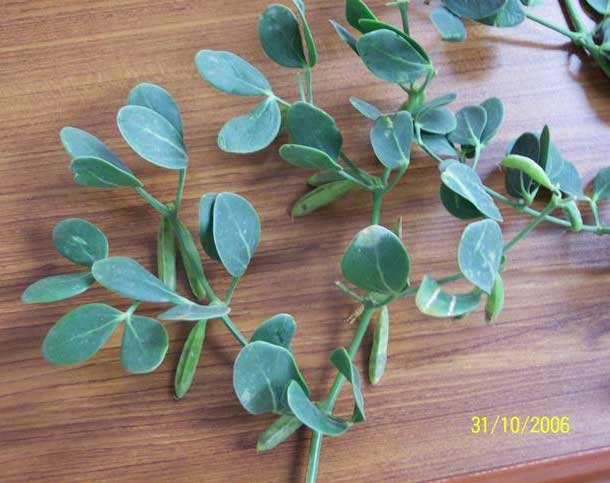
Zygophyllum fabago (*)
Classification System: APG IV
Superregnum: Eukaryota
Regnum: Plantae
Cladus: Angiosperms
Cladus: Eudicots
Cladus: Core eudicots
Cladus: Rosids
Cladus: Eurosids I
Ordo: Zygophyllales
Familia: Zygophyllaceae
Subfamilia: Zygophylloideae
Genus: Zygophyllum
Species: Zygophyllum fabago
Name
Zygophyllum fabago L.
Synonyms
Fabago alata Moench
Fabago major Sweet
Zygophyllum fabago L. subsp. dolichocarpum Popov ex Hadidi
Zygophyllum fabago L. subsp. orientale Boriss. ex Hadidi
Zygophyllum fabago Thunb.
Zygophyllum fabago var. brachycarpum auct. non Boiss.
Zygophyllum fabago L. var. brachycarpum Boiss. [1]]
References
Linnaeus, C. 1753. Species Plantarum. Tomus I: 385. Reference page.
USDA, ARS, Germplasm Resources Information Network. Zygophyllum fabago in the Germplasm Resources Information Network (GRIN), U.S. Department of Agriculture Agricultural Research Service. Accessed: 09-Oct-10.
Vernacular names
Deutsch: Bohnenähnliche Jochblatt
English: Syrian bean-caper
español: Morsana
français: Fabagelle
italiano: Favaggine
русский: Парнолистник обыкновенный
中文: 驼蹄瓣
Zygophyllum fabago is a species of plant known by the common name Syrian bean-caper. It is considered a noxious weed of economic importance in many of the western United States. It is native to Asia and East Europe (Russia and Ukraine) and Southeast Europe (Romania).[1]
Growth
The Syrian bean-caper grows long, thin stems with few oval-shaped, fleshy, waxy green leaflets each 2 to 3 centimeters in length. The flowers are small, compact bunches of five petals each with prominent stamens. The flowers have a taste and scent similar to caper. It grows in masses of individual plants, forming colonies, especially in dry, gravelly, saline, or disturbed areas where other plant life is rare.
Characteristics
The plant has invasive potential due to its long taproot which, even if fragmented, can produce a new plant, as well as the hardy wax coating on its leaves that tends to protect it from herbicides.
Chemical constituents
It contains about 0.002% harmine (entire plant).[2]
References
"Zygophyllum fabago". Germplasm Resources Information Network (GRIN). Agricultural Research Service (ARS), United States Department of Agriculture (USDA). Retrieved 2008-04-30.
"Erowid Online Books : "Ayahuasca: alkaloids, plants, and analogs" by Keeper of the Trout". www.erowid.org. Retrieved 2008-04-30.
Retrieved from "http://en.wikipedia.org/"
All text is available under the terms of the GNU Free Documentation License

